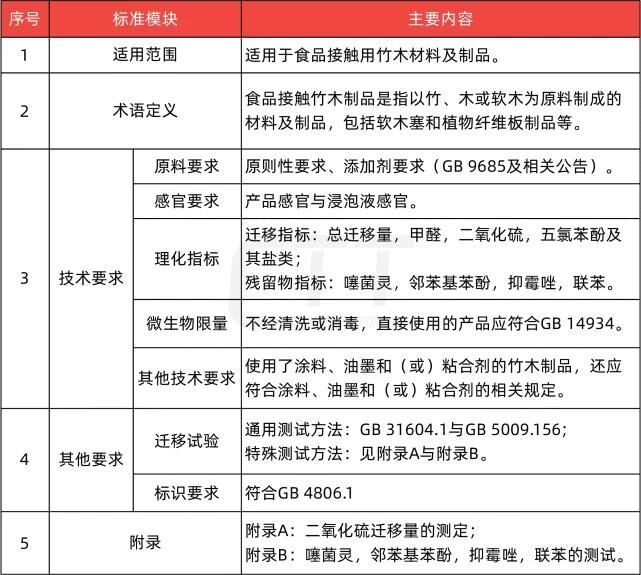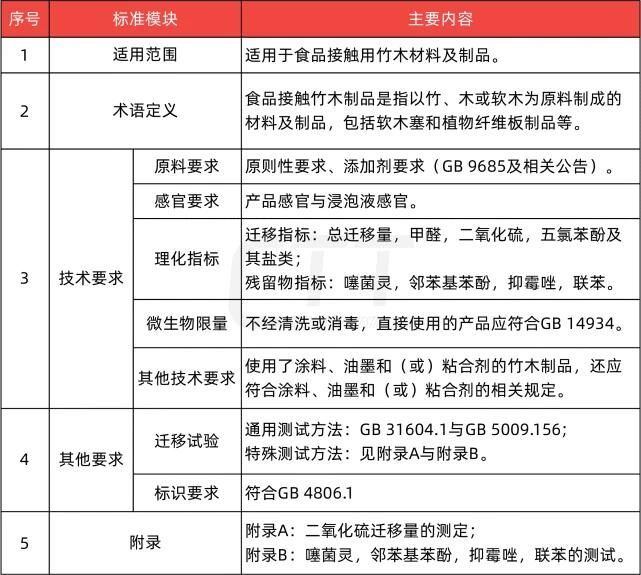On July 28, 2022, the National Health and Health Commission officially released the National Food Safety Standard Food Additive Eugenol (GB 1886.129- 2022) and other 36 national food safety standards and 3 amendments, including 3 related standards for food contact products.
The newly released relevant standards for food contact products are:
GB 4806.8-2022 "National Food Safety Standard-Food Contact Paper and Cardboard Materials and Products". This is the first revision of the product standard in six years, and will be implemented on June 30, 2023.
GB 4806.12-2022 "National Food Safety Standard - Bamboo and Wood Materials and Products for Food Contact". The release of this standard will change the status quo of the lack of relevant food safety standards for food contact bamboo and wood products, and will be implemented on December 30, 2022.
" GB 31604.53-2022 National Food Safety Standard - Determination of Migration of 5-Ethylidene-2-Norbornene in Food Contact Materials and Products". This standard is a test method standard for the migration of 5-ethylidene-2-norbornene and will be officially implemented on December 30, 2022.
Two new product standards are highlighted below :
GB 4806.8-2022 "National Food Safety Standard Food Contact Paper and Cardboard Materials and Products" is a revision of "National Food Safety Standard Food Contact Paper and Cardboard Materials and Products" (GB 4806.8-2016). The main changes in the standard are summarized in Table 1.
Table 1 Main revisions of GB 4806.8-2022
Analysis of important revisions
Delete potassium permanganate consumption and add chloropropanols, including 1,3-dichloro-2-propanol and 3-chloro-1,2-propanediol.
This revision is based on experimental analysis results and removes the indicator for potassium permanganate consumption due to lignin and total sugars in paper products. The standard is based on the results of risk assessment and combined with the actual situation of China's industry, and newly added residues of 1,3-dichloro-2-propanol (1,3-DCP) and 3-chloro-1,2-propanediol (3-MCPD) To effectively control its pollution; relevant production enterprises should strictly control the residues of chloropropanol in food contact paper and cardboard materials and products to ensure that they meet the limit requirements.
GB 4806.12-2022 "National Food Safety Standard for Food Contact Bamboo and Wood Materials and Products" is the first national food safety standard for food contact bamboo and wood products issued in my country. Compliance requirements and control basis. The main content of the standard is shown in Table 2 below.
Table 2 Main content of GB 4806.12-2022
Introduction and interpretation of core projects
( 1) Sensory requirements:
Sensory requirements are normal color, no burrs, moth-eaten, odor, mildew or other dirt. The soaking solution obtained from the migration test shall not have any deterioration of sensory properties such as precipitation, abnormal odor, abnormal coloration. Among them, moths do not apply to corks.
Risk interpretation:
Considering that bamboo and wood products have their own unique natural color and odor, the sensory requirements clause requires that the soaking solution obtained from the migration test should not have abnormal coloring and odor, so as to distinguish it from the normal color and smell of bamboo and wood products presented by the leachate.
( 2) Migrant indicators include:
· Total migration ≤10mg/dm2
· Formaldehyde≤15mg/kg
· Sulphur dioxide (water)≤10mg/kg
Pentachlorophenol and its salts (calculated as pentachlorophenol)≤0.15μg/kg
Risk interpretation:
1) Total migration characterizes the total amount of all non-volatile substances migrated out of food contact materials. These non-volatile substances can be harmful to organs and the nervous system if absorbed by the body in excess.
2) Bamboo and wood products for food contact are frequently used in daily use. Some manufacturers may use sulfur fumigation, hydrogen peroxide or sodium sulfate soaking and bleaching in the production process for their beautiful appearance, resulting in the product containing a large amount of sulfur dioxide, which is passed through bamboo. Wood products leaching into food and entering the human body through food or oral or skin contact may cause gastrointestinal symptoms such as nausea and vomiting.
3) Formaldehyde and PCP can be added to bamboo and wood products as preservatives in the production process of bamboo and wood products. If the removal of preservative substances is not thorough, these substances will migrate to food during the use of bamboo and wood products in contact with food. , and then enter the human body through food, and after a long-term accumulation in the human body or a large amount of inhalation, it may cause diseases.
( 3) Residue indicators include:
· Thiabendazole≤1.2mg/kg
· O-phenylphenol≤4.8mg/kg
· Imazalil≤0.4mg/kg
· Biphenyl≤0.6mg/kg
Risk interpretation:
At present, the fungicides and fungicides that may be used in bamboo and wood products include thiabendazole, o-phenylphenol, imazalil, biphenyl, etc. After the fungicides and fungicides are used to prevent fungi from bamboo and wood products, the residual fungicides may be It will migrate into food during the use of bamboo, wood and cork products, thus endangering human health.
Kind tips
The newly released standards GB 4806.8-2022 and GB 4806.12-2022 will provide strong guidance for the production and processing enterprises of food-contact bamboo and wood products and paper products to control product risks, provide government supervision departments with law enforcement basis, and will protect the health of consumers. , regulate corporate behavior, and maintain a good market order play an important role.
related suggestion

- ·【industry news】
A quick overview of the full t
- ·【industry news】
The new version of "Drinking W
- ·【industry news】
5 water quality testing standa
- ·【industry news】
Catalogue of National Food Saf
- ·【industry news】
my country has initially estab
share to:
keywords: the new laboratory analytical instruments, intelligent pre-processing equipment

